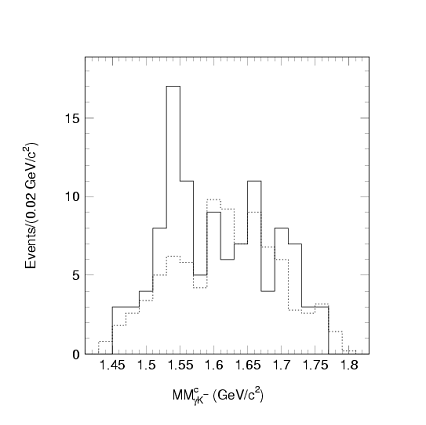 Evidence for a Narrow S = +1 Baryon Resonance in Photoproduction from the Neutron
Evidence for a Narrow S = +1 Baryon Resonance in Photoproduction from the Neutron Evidence for a Narrow S = +1 Baryon Resonance in Photoproduction from the Neutron
Evidence for a Narrow S = +1 Baryon Resonance in Photoproduction from the Neutron
 |
| Figure: The n(γ,K−)X missing mass spectrum
for the events
satisfied all the selection criteria (solid histogram) and the estimated background spectra (dotted histogram). |
γ + n → K− + Θ+ → K− + K+ + n
in the mass region
around 1.5 GeV/c2
where the past
experimental searches have not been carried out.
In the experiment,
a γ-ray beam
with energies of 1.5 - 2.4 GeV was used
and a plastic scintillator
which contains 12C was used
as a target.
K− mesons generated at the target were
detected with
the LEPS spectrometer.
The "missing" mass for the K− measurement can be
calculated and it gives the mass of Θ+ resonance
when the above reaction occurred.
Detecting K+ mesons
at the same time, we removed the "background" events that
K− are produced via the different reactions.
Most of the K− K+ pairs were produced
via the photoproduction of the φ meson and they were
excluded by using the K− K+
invariant mass.
In order to eliminate reactions
on protons in 12C and 1H at the target, the recoiled protons
were also detected.
For the events satisfied all these selection criteria,
we obtained the missing mass spectrum as shown
in the figure.
A sharp baryon resonance peak has been found at 1.54 ± 0.01 GeV/c2
above the background.
The Gaussian significance of the peak is 4.6 standard deviations,
or it is unlikely that the peak is just a statistical fluctuation.
The width of the resonance is estimated to be smaller than 25 MeV/c2.
It strongly indicates the existence of an S = +1 resonance
which may be attributed to the molecular meson-baryon resonance
or alternatively as an exotic five-quark baryon.
The mass and width are close to the prediction of a five-quark Θ+
resonance by the chiral soliton model by Diakonov, Petrov and Polyakov [Z. Phys. A 359,
305 (1997)].
Scientific Paper:
Physical Review Letters, 91, 012002 (2003),
4 July 2003
hep-ex/0301020 at
e-Print Archive